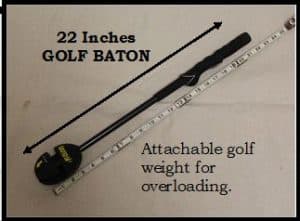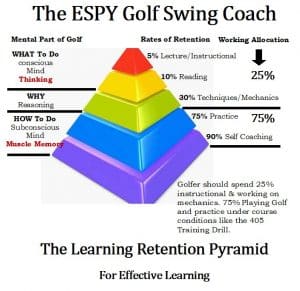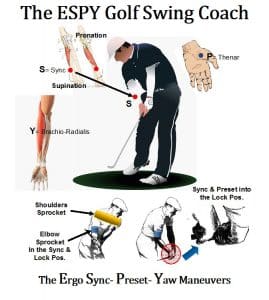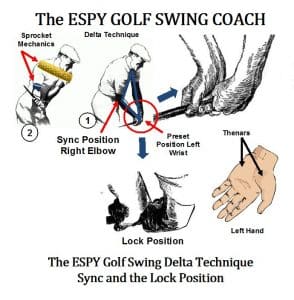The QATSPY Golfer’s Sports Page: Golf Swing Tips

By: Charles W. Boatright

Golf Swing Fundamentals Mental Horsepower in Golf is Like a Chess Match Played on Grass!
Judy Rankin announcing at the 2017 Women’s Open, alluded to golf as a chess game played on grass. Because of the pace that golf is played at, the golfer is not so much reacting to your their opponent as it is the golf course and applying their golf swing fundamentals. Judy Rankin description of how the golfer should approach their golf swing fundamentals highlights the basis of this article and my book, The ESPY Golf Swing Coach.
I’m going out on a limb to state that of all sports played, either by amateurs or professionals, golf is one of the most mentally taxing and demanding of all sports. Golf is like playing a chess match but on grass checkered board with hazards. Like in chess, it is the player who knows HOW to maximize their mental skills, using their tools effectively, and avoid hazards that usually tilts the balance of the match or round in their favor. It not the longest driver of the ball that wins, but the golf swing fundamentals within 150-yards of the green that has the advantage.
This is accomplished by placing more emphasis on one developing their golf swing fundamentals based on a rigid and disciplined training session answering the questions of WHY and HOW. The golfer must learn to develop their golf swing fundamentals, rather than just WHAT to execute. The WHAT is only 10-percent of the golf game. The golfer is relying more their muscle memory to develop their golf swing fundamental skills in golf rather than focusing on their swing thoughts.
A golfer’s training session shouldn’t be any different than their academic training. Schools main goal is to train students on HOW and WHY to think critically, rather than on WHAT to think. The golfer will never reach their full potential if they only focus on WHAT to perform instead of understanding HOW and WHY. My book, The ESPY Golf Swing Coach, allows the golfer to develop their golf swing fundamentals based on HOW the body, particularly the wrists and lower forearms synchronize with the golf club to produce golf shots with distance and control.
The Critical Swing Path in Developing One’s Golf Swing Fundamentals
There are critical muscles the golfer must focus on to develop muscle memory. There are two muscles located in the golfer’s wrists that has direct contact with the handle of the golf club, called Thenars (Hypothenar and Thenar). I develop a simple JUCO technique to allow the golfer to sync the golf club handle with their body to produce Power, Speed, and Control. This JUCO Technique is shown below:

The JUCO Technique, a golf swing fundamental use to Sync/Preset the golfer’s wrists and lower forearms.
The ESPY Golf Swing Auto-APP
If you want to capture the students’ commitment to their golf swing fundamentals, just explain WHY synchronizing the handle of the golf club with their wrists and lower forearms is critical. To help the golfer understand the simple golf swing fundamentals, the ESPY Golf Swing uses existing skills to take advantage of a will developed muscle memory, usually learned at a young age. The ESPY Golf Swing uses a technique called Autodidact and Apperception to create an efficient golf swing coach technique.
- The term Autodidact is the ability for someone to teach or to coach themselves a new skill or technique. The advantages of the Autodidact process is it has a 90 percent retention rate. Most golf lessons have a 15 percent retention rate.
- Apperception is the ability for someone to use a prior skill to help develop a new skill. This is like using the baseball-type swing to develop and take advantage of existing muscle memory for their golf swing fundamentals.
The Subconscious Mind, The Golfer’s Golf Swing Mechanics
The difference between HOW to use versus WHAT to use can’t be any more distinguishable and evidential than on the golf course. Golf teaches us that in highly critical situations, it is the person who knows how to naturally execute their golf swing base on a sequential routine can take advantage of the subconscious mind where 80 percent of the golfer’s potential is located. Critical thinking is just as much of a subconscious process as a conscious one. The golfer who uses muscle memory, or the subconscious process, does not rely on swing thoughts, or WHAT to think.
You ever heard someone state, “I don’t know what I was thinking!” This is exactly what happens in pressure situations after a critical golf shot is made. The golfer doesn’t have enough time to execute the golf swing and think about their golf swing fundamentals, mechanics, and techniques at the same time. These must be a muscle memory response based on Autodidact and Apperception process. The football coach will instruct their team that to perform at a high level, you can’t think, the player must execute what they have practiced. The player who has been trained, once they step on the field, their training automatically kick-in without thinking.
SEAL Teams and other specialized units are so highly trained under similar conditions, that their training kick-in and they automatically respond to the conditions. The golfer has to use the same process that I layout in Section 7 of my book called the 405- Training Drill.
Driving Hypnosis. While this is an unsafe situation for driving a vehicle down the highway, it works great for driving a golf ball down the fairway
The golfer has a tremendous advantage working in their favor, if they can recognize the strength and know how to use their subconscious mind correctly on the golf course. This advantage is referred to as Driving Hypnosis, or ExtraSensory Performance Technique. While this is an unsafe situation for driving a vehicle down the highway, it works great for driving a golf ball down the fairway.
What happens to the driver, or in this case the golfer, operating under Driving Hypnosis, or ExtraSensory Performance type golf swing technique is that most golf swing fundamentals and techniques are being performed by the subconscious mind, with the golfer not actively aware of their golf swing sequence. What happens to the driver is that most driving tasks performed are so routine that the driver doesn’t devote a large amount of conscious thought to certain tasks. The driver or golfer, in this case, is on auto-pilot. The only conscious thought the golfer has is their target or the ball. If the golfer has to think about something, think about being the ball or the target. This is a great golf swing technique to use in one’s golf game.
Also remember the quote from the movie Caddyshack- There’s a force in the universe that makes things happen. And all you have to do is get in touch with it, stop thinking, let things happen, and be the ball.
The Subconscious Mind, The Golfer’s Coach on the Golf Course
The mental edge in golf is where the conscious mind practices the golf shot routine under similar conditions of those on the course, making the subconscious mind become so familiar with the routine and situation that it takes over most of the task during training and on the course. Most tasks we perform during the day are performed by the subconscious mind anyway, requiring little conscious processing.
A great thing about the subconscious mind is that it does not perceive the time element or differentiate between reality and perception. So the time element in golf doesn’t become a factor. This is also critical to other activities we perform like riding a bicycle, where once you learn to ride the bicycle, you don’t forget or don’t think about riding the bicycle. The bicyclist is more concern about their exercise or their designation. The key factor in applying this technique to golf swing is convincing your subconscious mind that your golf swing fundamentals, mechanics, and techniques are reliable that the golfer can count on them on the golf course.
This same approach was used by Colonel George Robert Hall, who was held as a P.O.W. at the Hanoi Hilton for seven-and-a-half years. Upon his release, he shot his handicap of four (4) at the Greater New Orleans P.O.W. Open. This was six weeks after the date of his release. For more information on Colonel Hall’s story and my interview with Col. Hall, see Col. Hall- P.O.W. Veteran at the Hanoi Hilton
Swing thoughts are useless on the golf course, your mind should be in/or autopilot, especially when you are on the first tee box or trying to make an approach shot from the rough, about 8-yards off the edge of the green. This is where swing thoughts vanish into thin air, and you are wondering what you are going to do, while standing over your golf shot. Autopilot is how you are going to quiet the nerves. There is an important proverb- In quietness and confidence shall be your strength. The quiet mind (NOT THINKING) is essential to the golfer based on doing (HOW) not thinking (WHAT).
The conscious mind engaged in swing fundamentals and golf mechanics is similar to a commander performing detail task instead of managing the situation in the battle. The golfer has to learn to delegate the golf swing fundamentals and golf swing mechanics and techniques to the subconscious mind. The conscious mind has to perform course management, like target acquisition and ball orientation.
Morgan Pressel, during a rain delay interview at the 2015 Wal-Mart LPGA Tournament, made a very insightful observation about swing thoughts:
“Swing thoughts can be very confusing on the course.”
If you want to make a significant improvement in your golf game, work on establishing golf swing fundamentals and golf swing Muscle Memory (Mental Horsepower), instead of Swing Thoughts. Just remember how many times your conscious mind changes thoughts in evaluating a new situation that you have not faced before; same thing goes on with one golf swing.
Yogi Berra had a great question about swing thoughts- How can you think and hit at the same time? The answer to this question is you can’t.
NOW for the HOW- The military (Army, Marines, and Navy) have the best training available. The best method to establish fundamentals, muscle memory, or mental horsepower, under critical situations is to:
- Develop the most simplistic regimen possible, using only the essential elements, fewer the better, that have been tested; and don’t change what works. (No thinking, just execute).
- Use conscious, step-by-step repetition muscle memory, or basic training techniques, where each task can be performed flawlessly over a three-month period to a point it doesn’t require thinking. This will develop subconscious ability to perform the task as confidently as naturally, like riding a bicycle. Your conscious mind knows WHAT to do, acquire the target, but the subconscious mind knows HOW to naturally perform the task, based on fundamentals and muscle memory. Muscle memory is developed where the brain is directly wired to a particular muscle’s movement without having to go through a processor. This is like establishing a path in the jungle. You have to cut your way through jungle the first time, but the more you use the pathway, the more familiar, worn, clearer and easier the path becomes.

Golf baton used to develop the golfer’s golf swing mechanics with the Overload golf swing technique to form a natural and automatic golf swing.
Golf Baton Overload Golf Swing Mechanics
During the off-season months (December thru February), the golfer can continue working on their golf game, golf swing fundamentals, and mechanics, using a simple but effective overloaded golf baton technique. The golfer, following a simple (Sync, Preset, and Yaw) elements can develop and maintain their golf swing fundamentals and techniques using a training drill referred to as Overload/under-load technique.
This golf swing technique training process can increase club-head speed and power, similar to a baseball batter in the on deck circle using donut on their bat. This can be made from a discarded or an old golf club shaft and cutting-off 9-inches down from the bottom portion of the club handle. See top illustration. For more information on the golf baton, see http://goo.gl/t190rm and http://goo.gl/t190rm.
This same Overload approach, process, and sequence is included in my book where I spent over a seven-year period developing. I filled up three Xerox boxes with data in what became my Xerox Box Golf Research Project. Two boxes were labeled, “THIS DOES NOT WORK.” One partially-filled box was labeled, “THIS WORKS.” This single box became the basis for my book, The ESPY Golf Swing Coach.

820 East County Line Road, Ridgeland, MS 39157
My book can also be purchased on-line at:
Amazon.com
Barnes & Noble
This book is based on establishing the same situation that occurs in Driving Hypnosis. This can be applied to the golf swing, where the golfer uses three simple Ergonomic elements (Synch, Preset, and Yaw) to set up a repeatable and consistent golf swing that the golfer can perform automatically, like being on auto-pilot. The word Coach is significant in that the golfer is using a self-coaching process that is laid out in the book to teach the golf swing technique, based on the Learning Pyramid. Self-coaching has a 90 percent retention rate, compared to golf lessons that have a 20 percent retention rate.

By using a golf swing technique in my book, the golfer can use the left wrist and Thenars to CAM-OVER the Supinator muscle followed immediately by the right wrist and Thenar naturally CAMMING this syncs and locks the right elbow with the shoulders. These two maneuvers preset the golf club handle; see http://goo.gl/rpYJzQ. Presetting gives the golfer a significant advantage for power and control in their golf shots. This allow the golfer to preset the club handle and wrists as noted below.


For more information, check out my full library of BLOGS @ www.espygolfapp.com/blog or purchase your copy of The ESPY Golf Swing Coach, please visit my QATSPY website:
www.espygolfapp.com/store
Facebook- ESPY GOLF
Twitter- @cwboatright
Once you learn WHY, you don’t forget HOW!
Until next time– Be Synched, Tee-to-Green, with The ESPY Golf Swing!
Coach John Wooden’s seven step to success in sports and life:
- Success Is All About the Little Things – On the first day of practice, Coach Wooden didn’t discuss basketball strategy. Believe it or not, he taught his players the proper way to put on their socks and shoes, so they wouldn’t get blisters.
- Focus on the Process, Not the Outcome – Coach Wooden didn’t focus on winning. He focused on the character of his team, the key fundamentals, daily improvement, effort, and potential and selfless teamwork. As a result he won…a lot.
- There’s No Such Thing as an Overnight Success – Wooden was at UCLA 16 years, before the team won their first national title. Today, we live in a world where people expect instant results. If a coach doesn’t win a title in a few years, he or she is fired. Wooden’s coaching philosophy is a testament that greatness takes time.
- Selfless Teamwork is Great Teamwork – Wooden said, “A player who makes a team great is much more valuable than a great player.”
- There’s Power in Humility – Norman Vincent Peale said that humble people don’t think less of themselves. They just think of themselves less. Wooden made his life about coaching, leading and developing others, and, in doing so, exhibited true power.
- Faith Matters – In our politically correct world where people are afraid to mention God, even though it says it on our dollar bill, I find it interesting how, in all the media reports about Wooden, they talk positively about how his faith guided his life, principles, and actions. There is power in faith. More importantly, there is enormous power when your faith moves you to love, serve, inspire, coach, and make a difference.
- Your Legacy Matters – The most important thing you will leave behind when you die is your legacy. And the greatest legacy you can leave is your life, your principles, and the lives you touch. Wooden didn’t spend his life amassing wealth and trying to make a fortune. He invested in others. And, while buildings will fall, jewelry will tarnish, and money will get spent, his legacy will live on in those who carry his teachings in their heart.
A Recommendation for your Golf Game:
I would like to recommend an interesting radio program that I regularly listen to on my I-Heart Radio app on KARN 102.9 FM station, out of Little Rock, AR. They air a golf show called Arkansas Fairways and Greens, at 7:00 AM CT each Saturday morning, hosted by Bob Steel, and co-hosted by Jay Fox and Charles Crowson. Bob occasionally has on his show as his guest Alex Myers with Golf Digest and Ron Sirak with Golf Channel. This show is worth tuning into for golf news and information.
